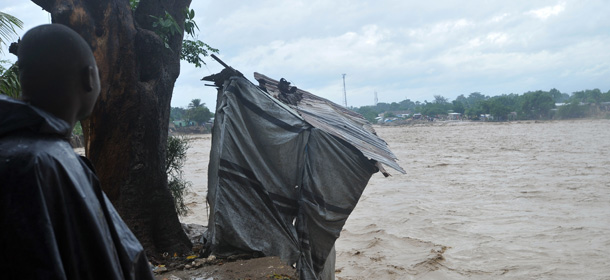Tutti i guai di Haiti
Il passaggio dell'uragano Sandy sull'isola che non è ancora uscita dall'epidemia di colera e dalle conseguenze del terremoto, nel racconto di Ettore Mo sul Corriere della Sera

A man views damage from heavy rains as a result of Hurricane Sandy October 25, 2012 in Port-au-Prince, Haiti. Hurricane Sandy barreled toward the Bahamas Thursday as a powerful category two storm, after battering Jamaica, Haiti and Cuba and claiming three lives so far. The US-based National Hurricane Center said the storm was packing winds of up to 105 miles (165 kilometers) per hour as it moved north, near the top of the category two range on the five-rung Saffir-Simpson wind scale. Forecasters predicted the storm would weaken somewhat over the next 48 hours. But Sandy will remain a hurricane as it passes over the Bahamas, according to the NHC’s 1500 GMT advisory. AFP PHOTO / THONY BELIZAIRE (Photo credit should read THONY BELIZAIRE/AFP/Getty Images)
Ettore Mo, uno dei più grandi inviati del giornalismo italiano, è stato ad Haiti, la “vittima dimenticata” dell’uragano Sandy, e ne ha raccontato sul Corriere della Sera.
È un sollievo poter confermare che la violenza con cui l’uragano Sandy ha investito nei giorni scorsi (24 e 25 ottobre) l’isola di Haiti è stata meno devastante di quanto annunciato nelle previsioni: resta tuttavia il fatto che l’epidemia di colera scatenata dall’immane terremoto nei Caraibi del gennaio 2010 continua ad imperversare. Oltre 7.000 le vittime entro il febbraio di quest’anno. Un bilancio che rimane approssimativo. I fiumi hanno sfondato gli argini, travolgendo con ondate di fango città e villaggi, dozzine di ponti distrutti, strade interrotte e impraticabili che hanno provocato l’isolamento di intere comunità, specie nella fascia Sud occidentale dell’isola. Particolarmente colpite, dopo la capitale, le città di Les Cayes, Léogâne e Jacmel. Si ritiene che almeno 200.000 persone siano state evacuate e abbiano trovato rifugio e sistemazione provvisoria nei vari centri d’accoglienza, già super affollati.
(continua a leggere su Corriere.it)
(THONY BELIZAIRE/AFP/Getty Images)



